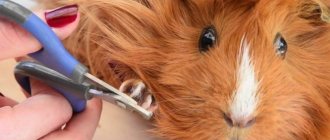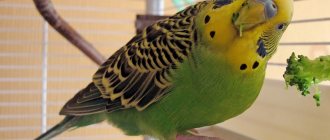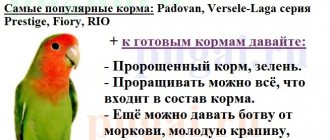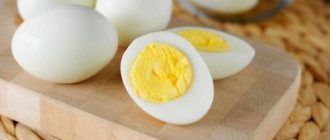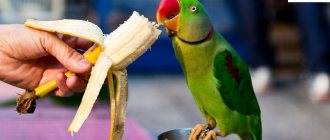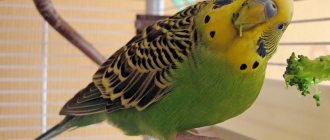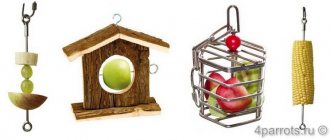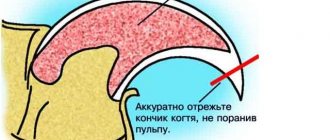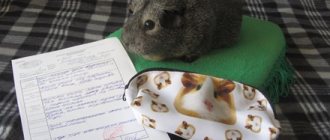Any pet requires care and close attention to itself. Parrots always require a special approach. Communication with the owner or relatives, good nutrition and good health are important for them.
One of the most important factors in the favorable existence of a feathered pet is the condition of its paws. Each owner of this animal should periodically trim its claws. This article is all about how to trim a parrot's claws, why it is necessary and methods of prevention.
Why do they cut their hair?
The life of budgies in the wild is very different from life in captivity. In nature, birds constantly fly, jump from branch to branch, sit on rough tree branches, so their claws themselves wear down as a result of friction against natural materials. In the cage, all the perches are smoothly polished and made of unnatural materials, when interacting with which the claws do not grind down. Small budgies, medium-sized cockatiels or large macaws need to have their nails trimmed.
Too long claws cause severe discomfort to your pet for many reasons:
- marigolds can cling to tissues on which the bird lands during flight, in which case the pet can dislocate a paw or twist a claw;
- the parrot feels pressure to move on flat surfaces and cannot sit comfortably on the perch;
- a pet can harm itself by trying to scratch its paws with overgrown nails;
- paws also cling to the bars of the cage.
In addition to natural growth, there are situations in which nail growth becomes too strong due to various diseases or problems in the body. Among these:
- liver diseases;
- curvature of fingers or other deformities associated with previous injuries;
- parasites (most often mites);
- poor living conditions;
- poor and unhealthy diet, which disrupts metabolism;
- lack of vitamins and minerals in the body.
Stitching claws naturally
The paws of parrots are developed and tenacious, with four fingers: the middle two are directed forward, the two are directed back. This structure helps birds wrap their fingers around branches and take food and other objects. Each finger ends in a strong curved claw.
Parrots living in the natural environment subject their legs to constant stress. They run on the ground, rocks, climb trees, and cling to branches. They pick and hold the fruits. Under such conditions, bird claws wear down on their own and do not have time to grow to a critical length. If this does happen, the parrot chews off the excess part or the nail breaks off.
But tamed pets often suffer from large claws. This is largely due to the wrong equipment: perches of the wrong diameter, made of cheap materials, lack of ropes with natural fibers. To naturally shorten the claws, the cage must have wooden perches at least one and a half centimeters thick. A budgie sits on such a stick without grasping it with its paw, and its claws touch the rough layer of the perch.
Preparation for the procedure
Before trimming a parrot's claws, you need to calm it down and set it in a positive mood. It is best to carry out the procedure at a veterinary clinic, but it is possible to do it yourself. To do this you will need special animal clippers. You can buy them at a veterinary store.
If this is not possible, then use a regular manicure set. But be sure to treat it with antiseptics before and after the procedure. You will also need cotton wool or cotton pads, a towel or gloves, and a product that stops the bleeding. During preparation, it is very important to determine exactly where the cut needs to be made, because birds have capillaries in their claws that cannot be touched. In order to do this, you need to shine a flashlight on your paw, so all the vessels will become visible.
How to trim a budgie's claws
The budgerigar is a miniature bird, and its claws are even tiny. Every owner of a feathered baby has to face the question of how to cut a parrot's nails. At first glance, coping with such an event is difficult and scary, but with experience comes confidence.
It is more convenient to carry out this procedure together, so get an assistant to hold the bird. Create the maximum possible illumination. Prepare in advance the tools needed to trim your parrot's claws:
- nail clipper, nippers or nail scissors;
- gloves;
- cotton wool;
- hemostatic agent.
Have a helper securely grasp the bird with both hands and hold it in a stationary position. Put on gloves, take the paw and examine it against the light: this way you will see a blood vessel in the finger. It must not be touched; the cutting should be 2 mm below the pulp. Having chosen the place to shorten, use pliers to carefully cut the long tip of the nail not across, but with a slight slope. Preserve the parrot's ability to cling.
Nail trimming process
Attention! Trim the nails accurately and quickly, making sure that the parrot's other fingers do not get caught in the tool.
How to trim claws correctly
To trim your pet's nails, grasp him in such a way that his wings are pressed against his back. To prevent bites, raise the animal's head. Bend your finger and cut off the excess length in one motion at an angle of 45 degrees from the floor. The procedure must be done carefully and so that your fingers do not get under the blade. It is best to treat your pet with a treat after this.
It is easy to determine whether the claws can be trimmed by looking at the parrot's gait. If it is uneven and your nails rest against the surface, then they cause discomfort. Usually the claws are cut when they reach 5 cm.
Prevention of nail growth
To cut your parrot's claws less often, you should take care to grind them down naturally. To do this, all plastic structures inside the cage are replaced with wooden ones. Instead of plastic perches, untreated branches of fruit trees with bark are placed. Their diameter should be such that the bird grasps 3/4 of them; for a budgerigar it is approximately 15 mm. Hemp ropes, ladders and toys made of wood and other natural materials are placed in the cage. You can set up a play area with small pebbles, dry cones and pieces of bark.
Sometimes excessive growth of claws is caused by poor health of the bird or an incorrectly selected diet. In such cases, after eliminating the cause, the excessive formation of horny substance stops.
What to do if your parrot is injured
No matter how hard you try to do everything carefully, bleeding can happen in any case. For example, if the paw or the stratum corneum of the claw with capillaries in it is touched. In this case, you need to press a cotton swab moistened with hydrogen peroxide to the bleeding area. You can also use a manganese crystal or a special agent that stops the blood.
After the procedure, the feathered pet will be scared and stressed. To alleviate its condition, it is better not to contact it for a while, because it will feel that you are a source of danger.
The structure of the claws
The parrot's claw consists of 2 parts: the cornea and the pulp. The pulp is the soft inner part that contains blood vessels and nerve endings. The horny sheath is devoid of capillaries and nerves; it covers the soft part on top. It is the horny part that grows, and it should be cut off without damaging the soft tissue.
To determine the location of the cut, the claw is illuminated from the side with a flashlight. The pulp is located at the base, the blood capillaries reach approximately the middle of the claw, and at the end there is a dead horny part.
When claws grow excessively, the soft tissue area also increases, so when treating paws in advanced cases, you need to be especially careful. With regular trimming, the capillaries and pulp will gradually shrink, returning to normal.
Prevention
In any case, it is impossible to trim a parrot's claws without scaring him or causing discomfort. Therefore, you should generally avoid excessive regrowth. There are special devices for this in pet stores. Sharpeners for claws and beaks are made from chalk and other natural materials. With their help, pets can get rid of overgrown length themselves.
You also need to replace all the plastic elements in the cage with wooden ones. Their surface should not be smooth. It is best to add pebbles to the bottom of the home. It is necessary to let the bird fly around the apartment more often. It is very important that the pet’s perch is at least 15 mm thick, because it is by sitting on such a branch that the parrot can wear down its nails naturally.
Why do you trim a parrot's claws?
Domestic parrots are limited in their movements; they have to be content with a cramped cage and walks on a smooth table. To ensure the possibility of grinding down the claws, abrasive surfaces are needed, which is not much in the apartment. Marigolds without work become thin and long, preventing the bird from walking normally and staying on the perch.
Parrots carefully preen themselves, smooth their feathers, clean and scratch their heads. There is a high chance that the paw will catch on something and get stuck. In an attempt to free itself, the bird risks dislocating a limb. Due to overgrown claws, the parrot is unable to walk fully, and this can lead to diseases of the paws over time. And finally, long claws sometimes peel and break. It hurts and may bleed.
What else causes excessive nail growth at home? There are several explanations for this:
- excess minerals;
- scabies mite;
- paw injuries;
- abnormal placement of fingers;
- poor metabolism.
If you are not sure whether your dog's nails need to be trimmed, watch him. When walking on the table, your fingers are in contact with the surface, which means no trimming is required. The finger is raised - the nail is too long and needs to be shortened.
Attention! An overgrown nail is dangerous - it can get into the bird's eye.
Is it possible to cut down
Some parrot owners try to solve the problem of excessively elongated horny formations on the paws of their charges by cutting them down with manicure files, or even needle files.
This would seem to be a good solution, since trimming with a nail clipper or nail clippers leaves sharp edges on the nails, while using a file can achieve a better result. However, experienced parrot owners do not recommend doing this under any circumstances, and veterinarians even prohibit doing this.
Important! Filing down claws
—
An extremely painful, unpleasant operation that provokes a state of shock in the bird.
Trimming the claws of a pet parrot
Self-confidence is the key to a successful procedure for trimming your cockatiel's nails. If there is a feeling of fear or your hands are shaking, you should consult a specialist. In any case, expect that the bird will struggle, and the procedure itself may be painful. To carry it out, you need to purchase special veterinary nippers. They are sold at any pet store. You also need to take care of your own hands and wear thick gloves. A means to stop the bleeding would be useful; anything can happen.
In order to trim the claws, you will have to turn your feathered friend over. He will bite and get angry, be careful not to wring the cockatiel's neck. You may need the help of a second person, one holding the bird, the other cutting off the long claws. Only the tip of the claw is removed; if you examine this part of the body well, you can see a darkening in the middle, this is a blood vessel. If you cut it, hemorrhage will begin, which will have to be stopped urgently.
Slowly you need to cut the claws one by one at a certain angle. Some people prefer to file down their feathered pet's claws. Veterinarians prohibit sawing. Such actions destroy the structure of the claw, causing delamination and discomfort for the cockatiel. When cutting with pliers, keep hemostatic powder on hand. It is poured onto cotton wool and applied to the wound. The medication should not be allowed to come into contact with other areas of the skin, as it can cause a burn. Pain when cutting is a cause for concern. Cockatiels are very shy and remember unpleasant sensations during certain actions. In the future it will be difficult to carry out this procedure, since the parrot will panic at the sight of the forceps.
After a pedicure, many pet parrots become offended by their owners and even become depressed. That is why it recommends preventing the growth of claws. Well, if a cosmetic procedure could not be avoided, you will have to put up with your feathered friend using treats. Cockatiels are vulnerable and sensitive creatures. They are afraid of pain and cannot understand a person when he does certain things, even for good. That is why it is better to prevent a problem than to fix it!
Trimming a cockatiel's nails is no different from a pedicure for a budgie. In any case, you need to be careful and pay attention to the location of the blood vessels. Only then will the parrot not feel discomfort from the procedure.
Rules
There is blood flow inside the claw. If possible, you should not touch him.
If you accidentally touched it and started bleeding, it’s okay. Stop the bleeding using a prepared hemostatic agent. Dip the nail clipper into the disinfectant container and continue the procedure.
It is necessary to cut off the tip of the claw at a distance of 1.5-2 mm from the bloodstream.
Trimming the claws of an unaccustomed bird alone is quite difficult, so it is better for you to look for an assistant in advance.
Be extremely careful when cutting. The parrot constantly twitches its paws and another finger may accidentally get caught between the blades of the scissors.
What is good about a special nail clipper? The fact that it allows you to cut off only one claw, without the possibility that you will accidentally touch the neighboring finger.
How they wear off in natural conditions
In the wild, parrots move through trees and ground in search of food. The hard bark prevents the claws from growing too long, undermining them. Poultry are deprived of this opportunity, because most surfaces around them have a smooth or soft structure.
The process of grinding down claws in the wild
The perch plays an important role in this process. It must be made of wood, with a diameter of at least one and a half centimeters and not polished.
There may be cases when a pet’s nails grow due to physiological characteristics. There may be several of them:
- metabolic disease;
- liver diseases;
- lack of vitamins;
- curvature of finger joints;
- scabies mite.
At the first suspicious symptoms, you should visit a veterinarian.
Read also
Is it possible to give a budgie a boiled egg?
Stress relief
Nail trimming is often a very stressful time for parrots. The bird may not only get scared, but also be offended by its owner. Therefore, you definitely need to prepare your bird’s favorite treat in advance. After pruning, the bird should be left alone for several days, no other procedures should be performed, and it should be protected from possible distress. Little birds (wavy birds, lovebirds) will definitely appreciate a gift in the form of a caged toy.
This is interesting: Bob haircut with extension
What are the consequences of growing claws on a parrot?
There is disagreement among parrot breeders about whether or not to trim your parrot's nails. The main argument of opponents of this procedure looks like this: in its natural habitat, no one runs after a bird with scissors.
Proponents of cutting nails of small breeds, including budgerigars, give several reasons why this is necessary:
- Overgrown nails prevent the bird from walking and sitting on the perch.
- If the bird wants to scratch itself, it will hurt itself with an overgrown claw.
- If a bird sits on a fleecy fabric - a blanket or carpet, during a sharp take-off it runs the risk of tearing out a claw caught in the pile, or even dislocating its paw. As a result of such an injury, the bird may become disabled or die.
- Large breeds of parrots can bite off the overgrown part of the nail themselves; budgerigars do not have this opportunity, since their beak is not of sufficient size.
Important! In the room where budgies are kept, it is not advisable to lay carpets or hang fleecy fabrics outside the cage, on which the bird can get caught and injure itself.
Trimming a pet's nails should be done safely for the bird, using special tools and antiseptics that are prepared in advance. The parrot's nails need to be cut as the keratinized tissue grows back.
Necessary tools for cutting
To trim your nails you will need:
- “ nail clipper ” (You can buy it at a pet store. If you suddenly can’t get it, you can use small scissors (manicure scissors are great) or nail clippers.);
- cotton wool;
- hemostatic powder or powder (If you can’t find it anywhere, then there should be at least a solution of hydrogen peroxide. It is not recommended to use potassium permanganate when bleeding, it can cause a burn. As a last resort, if you can’t get any powder, dilute a very weak solution of potassium permanganate. );
- gloves (Many people don’t use them. But trimming is stressful for a budgie, so it can bite hard. To avoid being bitten, trim your budgie’s nails while wearing gloves.).
When to cut
Some budgies bite their own claws if they grow long. But there are only a few such individuals. The rest of the parrots need help in this matter.
How do you know when it's time to trim your nails? It's simple. Let your parrot fly. When he lands on a flat, hard, horizontal surface, you should watch his paws. If the tip of the finger - the part from which the claw begins to grow - does not touch the surface and the fingers seem to be at an angle due to the size of the claw, then it is time to make the claws shorter. If the fingers touch the entire surface and when the parrot walks, the fingers do not fall to the side (do not bend), but stand straight, then it is too early to shorten the claws.

